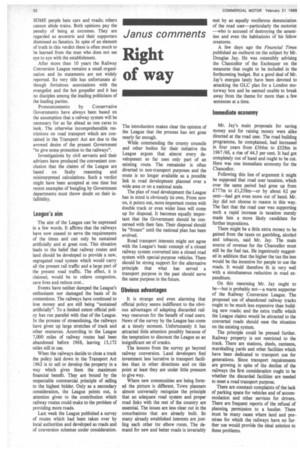Janus comments
Page 54

If you've noticed an error in this article please click here to report it so we can fix it.
Right of way
The introduction makes clear the opinion of the League that the process has not gone nearly far enough.
While commending the county councils and other bodies for their initiative the League argues that almost every development so far uses only part of an existing route. The remainder is often diverted to non-transport purposes and the route is no longer available as a possible link in road development planned over a wide area or on a national scale.
The plan of road development the League has in mind is obviously its own. From now on, it points out, more important routes with double track or even wider lines will come up for disposal. It becomes equally important that the Government should be concerned with their fate. Their disposal should be "frozen" until the national plan has been evolved.
Road transport interests might not agree with the League's basic concept of a closed railway system converted into a closed road system with special-purpose vehicles. There should be strong support for the alternative principle that what has served a transport purpose in the past should serve the same purpose in the future.
Obvious advantages It is strange and even alarming that official policy seems indifferent to the obvious advantages of adapting discarded railway resources for the benefit of road users. News of the survey by the League has come at a timely moment. Unfortunately it has attracted little attention possibly because of the temptation to discount the League as an insignificant set of cranks.
The lessons from the survey go beyond railway conversion. Land developers find investment less lucrative in transport facilities than in other directions and on this point at least they are under little pressure to give way.
Where new communities are being formed the picture is different. Town planners almost universally recognize the principle that an adequate road system and proper road links with the rest of the country are essential. The issues are less clear cut in the conurbations that are already built. So many already established interests are jostling each other tor elbow room. The demand for new and better roads is invariably met by an equally vociferous denunciation of the road user—particularly the motorist —who is accused of destroying the amenities and even the habitations of his fellow creatures.
A few days ago the Financial Times published an outburst on the subject by Mr. Douglas Jay. He was ostensibly advising the Chancellor of the Exchequer on the measures that ought to be included in the forthcoming budget. But a good deal of Mr. Jay's energies lately have been devoted to attacking the GLC plan for a London motorway box and he seemed unable to break away from the theme for more than a few sentences at a time.
Immediate economy Mr. Jay's main proposals for saving money and for raising money were alike directed at the road user. The road building programme, he complained, had increased in four years from £366m to £528m in 1967/68, a rise of 44.3 per cent. It had got completely out of hand and ought to be cut. Here was one immediate economy for the Chancellor.
Following this line of argument it might be supposed that road user taxation, which over the same period had gone up from £777m to £1,258m—or by about 62 per cent—had got even more out of hand. Mr. Jay did not choose to reason in this way. The fact that the road user was supporting such a rapid increase in taxation merely made him a more likely candidate for further impositions.
There might be a little extra money to be gained from the taxes on gambling, alcohol and tobacco, said Mr. Jay. The main source of revenue for the Chancellor must still be the fuel tax. He ingeniously suggested in addition that the higher the tax the less would be the incentive for people to use the roads. It would therefore fit in very well with a simultaneous reduction in road expenditure.
On this reasoning Mr. Jay ought to be—but is probably not—a warm supporter of the Railway Conversion League. The proposed use of abandoned railway tracks ought to be much less expensive than building new roads; and the extra traffic which the League claims would be attracted to the converted roads should ease the situation on the existing system.
The principle could be pressed further. Railway property is not restricted to the track. There are stations, sheds, canteens, marshalling yards and other facilities which have been dedicated to transport use for generations. Since transport requirements are growing in spite of the decline of the railways the first consideration ought to be whether the discarded facilities are needed to meet a road transport purpose.
There are constant complaints of the lack of parking space for vehicles and of accommodation and other services for drivers. There are frequent reports of the refusal of planning permission to a haulier. There must be many cases where land and pre-, mises for which the railways have no further use would provide the ideal solution to these problems.












































































































